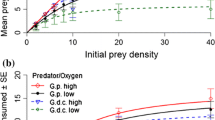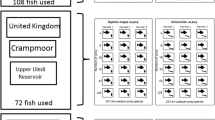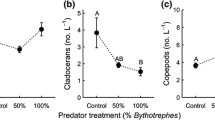Abstract
Introduced species may suppress or enhance ecological functions, or they may have neutral effects in ecosystems where they replace or complement native species. Few studies, however, have explicitly tested for these trajectories, and for the effect these might have for native species. In this study, we experimentally test the trajectory and scale of change in the function of ‘carrion removal’ at different carrion loads along ocean beaches in Eastern Australia that have different numbers of introduced red foxes (Vulpes vulpes) and several species of native raptors. We hypothesized that the ‘positive’ effect of foxes on carrion removal would be greatest at high carrion loads, because competition for resources between native and introduced species is lower. Scavenger abundance, fox occurrences, and carrion consumption by these species differed widely between locations and times. Despite distinct spatial differences in the structure of vertebrate scavenger assemblages, total carrion consumption was not significantly different between locations at any carrion load. This lack of variation in functional rates indicates potential functional plasticity in the scavenger assemblage and possible functional accommodation of red foxes. Neutral fox effects on ecological functions or the ecosystem more broadly are, however, very unlikely to extend beyond carrion consumption.




Similar content being viewed by others
References
Anderson MJ, Gorley RN, Clarke RK (2008) Permanova+ for primer: guide to software and statistical methods. Primer-E Limited, Plymouth, UK
Behrendorff L et al (2016) Insects for breakfast and whales for dinner: the diet and body condition of dingoes on Fraser Island (K’gari). Sci Rep. https://doi.org/10.1038/srep23469
Bergstrom DM et al (2009) Indirect effects of invasive species removal devastate World Heritage Island. J Appl Ecol 46:73–81. https://doi.org/10.1111/j.1365-2664.2008.01601.x
Bomford M, O’Brien P (1995) Eradication or control for vertebrate pests? Wildl Soc Bull 1973–2006(23):249–255
Borland HP, Schlacher TA, Gilby BL, Connolly RM, Yabsley NA, Olds AD (2017) Habitat type and beach exposure shape fish assemblages in the surf zones of ocean beaches. Mar Ecol Prog Ser 570:203–211. https://doi.org/10.3354/meps12115
Broadbent A, Stevens CJ, Peltzer DA, Ostle NJ, Orwin KH (2018) Belowground competition drives invasive plant impact on native species regardless of nitrogen availability. Oecologia 186:577–587. https://doi.org/10.1007/s00442-017-4039-5
Brown MB et al (2015) Invasive carnivores alter ecological function and enhance complementarity in scavenger assemblages on ocean beaches. Ecology 96:2715–2725
Buechley ER, Sekercioglu CH (2016) The avian scavenger crisis: looming extinctions, trophic cascades, and loss of critical ecosystem functions. Biol Conserv 198:220–228. https://doi.org/10.1016/j.biocon.2016.04.001
Calver M, King D, Short J (1998) Ecological blunders and conservation: the impact of introduced foxes and cats on Australian native fauna. J Biol Educ 32:67–72
Chan DK, Tsui HC, Kot BC (2017) Database documentation of marine mammal stranding and mortality: current status review and future prospects. Dis Aquat Org 126:247–256
Chapin FS et al (2000) Consequences of changing biodiversity. Nature 405:234–242. https://doi.org/10.1038/35012241
Core Team R (2014) R: a language and environment for statistical computing. R Foundation for Statistical Computing, Vienna
Cortes-Avizanda A, Carrete M, Donazar JA (2010) Managing supplementary feeding for avian scavengers: guidelines for optimal design using ecological criteria. Biol Conserv 143:1707–1715. https://doi.org/10.1016/j.biocon.2010.04.016
Crowl TA, Crist TO, Parmenter RR, Belovsky G, Lugo AE (2008) The spread of invasive species and infectious disease as drivers of ecosystem change. Front Ecol Environ 6:238–246. https://doi.org/10.1890/070151
DeFries RS, Foley JA, Asner GP (2004) Land-use choices: balancing human needs and ecosystem function. Front Ecol Environ 2:249–257. https://doi.org/10.1890/1540-9295(2004)002[0249:Lcbhna]2.0.Co;2
DeFries R, Hansen A, Turner BL, Reid R, Liu J (2007) Land use change around protected areas: management to balance human needs and ecological function. Ecol Appl 17:1031–1038
Dexter N, Murray A (2009) The impact of fox control on the relative abundance of forest mammals in East Gippsland, Victoria. Wildl Res 36:252–261
Dickman CR (1996) Impact of exotic generalist predators on the native fauna of Australia. Wildl Biol 2:185–195
Didham RK, Tylianakis JM, Hutchison MA, Ewers RM, Gemmell NJ (2005) Are invasive species the drivers of ecological change? Trends Ecol Evol 20:470–474. https://doi.org/10.1016/j.tree.2005.07.006
Dunlop JA, Rayner K, Doherty TS (2017) Dietary flexibility in small carnivores: a case study on the endangered northern quoll, Dasyurus hallucatus. J Mammal 98:858–866. https://doi.org/10.1093/jmammal/gyx015
Ebbert S, Byrd G (2002) Eradications of invasive species to restore natural biological diversity on Alaska Maritime National Wildlife Refuge. Turning the tide: the eradication of invasive species (CR Veitch and MN Clout, Editors). IUCN Invasive Species Specialist Group, Gland, Switzerland and Cambridge, United Kingdom: pp 102–109
Ellis JC (2005) Marine birds on land: a review of plant biomass, species richness, and community composition in seabird colonies. Plant Ecol 181:227–241. https://doi.org/10.1007/s11258-005-7147-y
Finke DL, Denno RF (2005) Predator diversity and the functioning of ecosystems: the role of intraguild predation in dampening trophic cascades. Ecol Lett 8:1299–1306. https://doi.org/10.1111/j.1461-0248.2005.00832.x
Fleming PA, Anderson H, Prendergast AS, Bretz MR, Valentine LE, Hardy GES (2014) Is the loss of Australian digging mammals contributing to a deterioration in ecosystem function? Mammal Rev 44:94–108. https://doi.org/10.1111/mam.12014
Gilby BL, Olds AD, Yabsley NA, Connolly RM, Maxwell PS, Schlacher TA (2017) Enhancing the performance of marine reserves in estuaries: just add water. Biol Cons 210:1–7. https://doi.org/10.1016/j.biocon.2017.03.027
Gitay H, Wilson JB, Lee WG (1996) Species redundancy: a redundant concept? J Ecol 84:121–124
Glen AS, Dickman CR (2005) Complex interactions among mammalian carnivores in Australia, and their implications for wildlife management. Biol Rev 80:387–401. https://doi.org/10.1017/S1464793105006718
Glen AS, Dickman CR, Soule ME, Mackey B (2007) Evaluating the role of the dingo as a trophic regulator in Australian ecosystems. Austral Ecol 32:492–501
Gurevitch J, Padilla DK (2004) Are invasive species a major cause of extinctions? Trends Ecol Evol 19:470–474. https://doi.org/10.1016/j.tree.2004.07.005
Hubbell SP (2005) Neutral theory in community ecology and the hypothesis of functional equivalence. Funct Ecol 19:166–172. https://doi.org/10.1111/j.0269-8463.2005.00965.x
Huijbers CM, Schlacher TA, Schoeman DS, Weston MA, Connolly RM (2013) Urbanisation alters processing of marine carrion on sandy beaches. Landsc Urban Plan 119:1–8. https://doi.org/10.1016/j.landurbplan.2013.06.004
Huijbers CM, Schlacher TA, Schoeman DS, Olds AD, Weston MA, Connolly RM (2015) Limited functional redundancy in vertebrate scavenger guilds fails to compensate for the loss of raptors from urbanized sandy beaches. Divers Distrib 21:55–63. https://doi.org/10.1111/ddi.12282
Huijbers CM et al (2016a) Functional replacement across species pools of vertebrate scavengers separated at a continental scale maintains an ecosystem function. Funct Ecol 30:998–1005. https://doi.org/10.1111/1365-2435.12577
Huijbers CM et al (2016b) Functional replacement across species pools of vertebrate scavengers separated at a continental scale maintains an ecosystem function. Funct Ecol 30:998–1005. https://doi.org/10.1111/1365-2435.12577
Janzen DH (1977) Why fruits rot, seeds mold, and meat spoils. Am Nat 111:691–713
Johnson CN, VanDerWal J (2009) Evidence that dingoes limit abundance of a mesopredator in eastern Australian forests. J Appl Ecol 46:641–646
Keane RM, Crawley MJ (2002) Exotic plant invasions and the enemy release hypothesis. Trends Ecol Evol 17:164–170. https://doi.org/10.1016/S0169-5347(02)02499-0
Kinnear JE, Sumner NR, Onus ML (2002) The red fox in Australia—an exotic predator turned biocontrol agent. Biol Conserv 108:335–359. https://doi.org/10.1016/S0006-3207(02)00116-7
Leibold MA, McPeek MA (2006) Coexistence of the niche and neutral perspectives in community ecology. Ecology 87:1399–1410
Loreau M (2004) Does functional redundancy exist? Oikos 104:606–611
Losos JB (2011) Convergence, adaptation, and constraint. Evolution 65:1827–1840. https://doi.org/10.1111/j.1558-5646.2011.01289.x
Lyons KG, Schwartz MW (2001) Rare species loss alters ecosystem function ± invasion resistance. Ecol Lett 4:358–365
Macdonald DW (1976) Food caching by red foxes and some other carnivores. Ethology 42:170–185. https://doi.org/10.1111/j.1439-0310.1976.tb00963.x
Macdonald D, Baker S (2004) Non-lethal control of fox predation: the potential of generalised aversion. Anim Welf 13:77–86
Maslo B et al (2016) Regional drivers of clutch loss reveal important trade-offs for beach-nesting birds. PeerJ 4:e2460
Meager JJ, Schlacher TA, Nielsen T (2012) Humans alter habitat selection of birds on ocean-exposed sandy beaches. Divers Distrib 18:294–306. https://doi.org/10.1111/j.1472-4642.2011.00873.x
M’Gonigle LK, Mazzucco R, Otto SP, Dieckmann U (2012) Sexual selection enables long-term coexistence despite ecological equivalence. Nature 484:506–509. https://doi.org/10.1038/nature10971
Moreno-Opo R, Margalida A, García F, Arredondo Á, Rodríguez C, González LM (2012) Linking sanitary and ecological requirements in the management of avian scavengers: effectiveness of fencing against mammals in supplementary feeding sites. Biodivers Conserv 21:1673–1685. https://doi.org/10.1007/s10531-012-0270-x
Morton B, Jones DS (2003) The dietary preferences of a suite of carrion-scavenging gastropods (Nassariidae, Buccinidae) in Princess Royal Harbour, Albany, Western Australia. J Mollus Stud 69:151–156. https://doi.org/10.1093/mollus/69.2.151
Ogada DL, Torchin ME, Kinnaird MF, Ezenwa VO (2012) Effects of vulture declines on facultative scavengers and potential implications for mammalian disease transmission. Conserv Biol 26:453–460
Olsen J, Fuentes E, Rose AB (2006) Trophic relationships between neighbouring White-bellied Sea-Eagles (Haliaeetus leucogaster) and Wedge-tailed Eagles (Aquila audax) breeding on rivers and dams near Canberra. Emu 106:193–201. https://doi.org/10.1071/mu05046
Pyšek P et al (2012) A global assessment of invasive plant impacts on resident species, communities and ecosystems: the interaction of impact measures, invading species’ traits and environment. Glob Change Biol 18:1725–1737
Saunders GR, Gentle MN, Dickman CR (2010) The impacts and management of foxes Vulpes vulpes in Australia. Mamm Rev 40:181–211. https://doi.org/10.1111/j.1365-2907.2010.00159.x
Schlacher TA, Connolly RM (2009) Land–ocean coupling of carbon and nitrogen fluxes on sandy beaches. Ecosystems 12:311–321
Schlacher TA, Strydom S, Connolly RM (2013) Multiple scavengers respond rapidly to pulsed carrion resources at the land-ocean interface. Acta Oecol 48:7–12. https://doi.org/10.1016/j.actao.2013.01.007
Schlacher TA et al (2015a) Conservation gone to the dogs: when canids rule the beach in small coastal reserves. Biodivers Conserv 24:493–509. https://doi.org/10.1007/s10531-014-0830-3
Schlacher TA, Weston MA, Schoeman DS, Olds AD, Huijbers CM, Connolly RM (2015b) Golden opportunities: a horizon scan to expand sandy beach ecology. Estuar Coast Shelf S 157:1–6. https://doi.org/10.1016/j.ecss.2015.02.002
Schlaepfer MA, Sax DF, Olden JD (2011) The potential conservation value of non-native species. Conserv Biol 25:428–437. https://doi.org/10.1111/j.1523-1739.2010.01646.x
Schmitz OJ (2008) Effects of predator hunting mode on grassland ecosystem function. Science 319:952–954. https://doi.org/10.1126/science.1152355
Short J, Smith A (1994) Mammal decline and recovery in Australia. J Mamm 75:288–297
Smith GC (2016) An analysis of prey remnants from osprey Pandion haliaetus and white-bellied sea-eagle Haliaetus leucogaster feeding roosts. Emu 85:198–200. https://doi.org/10.1071/mu9850198
Spiller DA et al (2010) Marine subsidies have multiple effects on coastal food webs. Ecology 91:1424–1434
Tilman D, Isbell F, Cowles JM (2014) Biodiversity and ecosystem functioning. Annu Rev Ecol Evol Syst 45:93–112
Tumolo BB, Flinn MB (2017) Top-down effects of an invasive omnivore: detection in long-term monitoring of large-river reservoir chlorophyll-a. Oecologia 185:293–303. https://doi.org/10.1007/s00442-017-3937-x
Van Kleunen M et al (2015) Global exchange and accumulation of non-native plants. Nature 525:100–103
Vilà M et al (2011) Ecological impacts of invasive alien plants: a meta-analysis of their effects on species, communities and ecosystems. Ecol Lett 14:702–708
Wagnon CJ, Serfass TL (2017) Use of camera traps provides insight into the feeding ecology of red foxes Vulpes vulpes. Can Field-Nat 131:19. https://doi.org/10.22621/cfn.v131i1.1950
Walker B (1995) Conserving biological diversity through ecosystem resilience. Conserv Biol 9:747–752
Wilson EE, Wolkovich EM (2011) Scavenging: how carnivores and carrion structure communities. Trends Ecol Evol 26:129–135. https://doi.org/10.1016/j.tree.2010.12.011
Wood S (2012) mgcv: Mixed GAM Computation Vehicle with GCV/AIC/REML smoothness estimation
Acknowledgements
The authors acknowledge the spending help of Andreas Fischer, Hayden Borland, Tom Brook, Makeely Blanford, Cassandra Duncan, Sarah Thackwray, and Rachel Bycroft for their commitment to the deployment of copious kilograms of pungent mullet. Financial support for this study was provided by the University of the Sunshine Coast in the form of a Vice Chancellor’s bursary to ELB, SeaWorld Research and Rescue Foundation, Sekisui House, and Water Sciences Collaborative Research Network (CRN).
Author information
Authors and Affiliations
Contributions
EB, TS, BG, and AO conceived the idea and designed the experiments; EB, BG, TS, AO, CH, CP, and CV conducted the experiments; EB, BG, and TS analysed the data; all authors contributed equally to the interpretation of results, and editing the manuscript.
Corresponding author
Ethics declarations
Conflict of interest
The authors declare they have no conflict of interest.
Ethics approval
All procedures performed in studies involving human participants were in accordance with the ethical standards of the institutional and/or national research committee and with the 1964 Helsinki declaration and its later amendments or comparable ethical standards. All applicable institutional and/or national guidelines for the care and use of animals were followed.
Data availability
The data sets generated during and/or analysed during the current study are available in the Zenodo repository; https://zenodo.org/record/1195793#.WqXRZJNuZTY.
Additional information
Communicated by Janne Sundell.
Electronic supplementary material
Below is the link to the electronic supplementary material.
Rights and permissions
About this article
Cite this article
Bingham, E.L., Gilby, B.L., Olds, A.D. et al. Functional plasticity in vertebrate scavenger assemblages in the presence of introduced competitors. Oecologia 188, 583–593 (2018). https://doi.org/10.1007/s00442-018-4217-0
Received:
Accepted:
Published:
Issue Date:
DOI: https://doi.org/10.1007/s00442-018-4217-0




